
This interesting plant gets its common name from the exotic flowers that look like strands of chenille yarn. Other descriptive common names include Foxtails, Monkey Tail and Red-hot Cat’s Tail. Native to the South Pacific (New Guinea and the Malay Archipelago), Acalypha hispida is a tropical shrub in the spurge family (Euphorbiaceae). Because it is only hardy to zone 10, it is usually grown as a houseplant or seasonal annual for its unusual tassel-like flowers. This evergreen plant can grow to 15 feet tall and 8 feet wide in suitable climates but in containers will remain much smaller. It thrives in hot, humid summer climates.
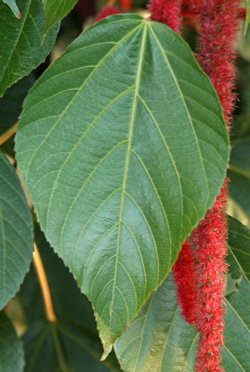
Large, bright green heart-shaped leaves with toothed margins are produced on sparsely branched upright to arching stems. In tropical locations it will become a large shrub but can be maintained as a small plant by continual pruning. It is vigorous and easy to grow as a container plant or seasonally in the landscape.
This plant is dioecious, producing male and female flowers on different plants. The soft and fuzzy pendulous female inflorescences are typically crimson red but there is a white cultivar (‘Alba’) and another with cream colored flowers (‘White Margined’ which also has creamy white teeth on the leaf margins). The flowers themselves are very small, mostly just feathery pistils but are tightly packed along the raceme to form the furry catkin. These catkins that arise from the leaf axils are very long-lasting, gradually fading and browning as they age, but regular dead-heading the spent flowers will encourage more blooms. Flowers are produced any time of the year when temperatures are warm enough (year round in tropical climates). The male flowers are not showy, so the plants offered as ornamentals are all females.
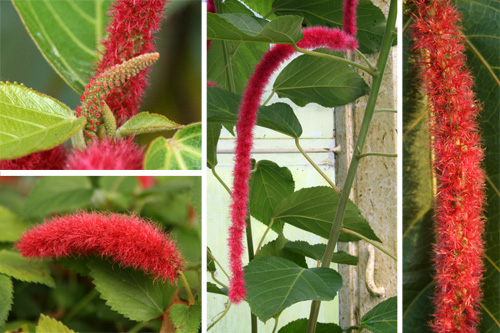
Because the hanging flowers can get up to 18 inches long, the plants are best grown in hanging baskets or elevated containers, but they can be planted in the ground, making great accent plants or dramatic specimens.
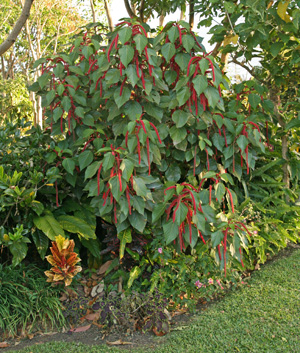
A. hispida needs bright light and warm temperatures to flower well. As a tropical plant it does not like it when temperatures drop below 50ºF, and really prefers temperatures above 60ºF. It also needs to be kept moist but not wet and should never be allowed to dry out completely. If possible, keep water off the flowers in order to prevent disease. Plant in a good general purpose potting medium. Fertilize container-grown plants frequently, as this is a heavy feeder when forming flowers. Use either diluted water soluble fertilizer in regular waterings or use a slow release granular product. Chenille plant should be pruned to produce more compact growth and more flowers. This plant has few pests, but spider mites, whiteflies and mealybugs can be a problem.
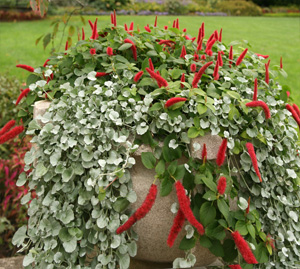
Chenille plant is often grown as an annual, but since it really is a tender perennial it can be brought indoors to be kept over the winter as a houseplant. It needs as much light and humidity as possible during the winter, when water and fertilizer should be reduced. But unless you have a greenhouse to provide optimal conditions, it will likely decline somewhat during the winter. It may revive in the spring when better conditions prevail and it can be moved outside for the summer after all danger of frost has passed, but as it ages it often becomes woody and rangy, and flowering decreases. It is often best just to take cuttings and start anew each spring, discarding the original plant. Propagate new plants by rooting 4-6″ pieces with at least
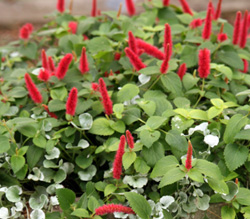
two leaves in perlite or similar rooting medium (using rooting hormone and bottom heat to enhance the results). Stem cuttings are best taken in early spring. It can also be grown from seed, but will take a while to flower and you may end up with non-showy male plants.
Like many other members of the spurge family, the sap of this plant can cause skin irritation in sensitive individuals and ingestion may cause stomach upset, so it should be kept away from children.
The related dwarf chenille plant, A. pendula, is a low, ground-hugging plant that produces bright red, erect flowers.
– Susan Mahr, University of Wisconsin – Madison
Latest from Wisconsin Yard & Garden
Ask Your Gardening Question
If you’re unable to find the information you need, please submit your gardening question here:





 Marigolds
Marigolds Create a Butterfly Garden
Create a Butterfly Garden Plant Flowers to Encourage Beneficial Insects
Plant Flowers to Encourage Beneficial Insects Forcing Bulbs
Forcing Bulbs


